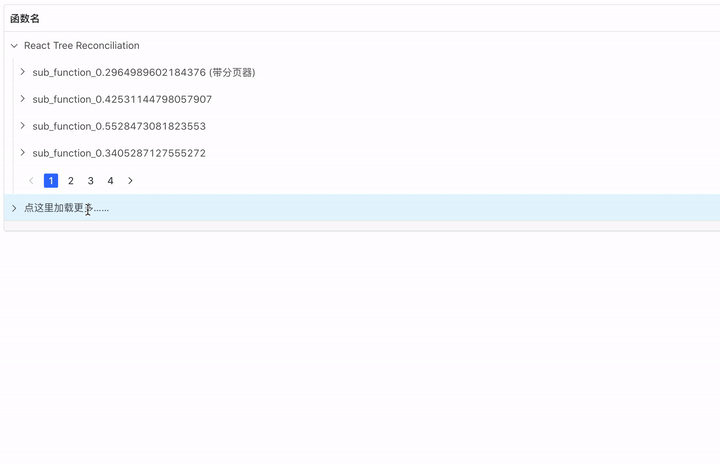前言
最近在一个业务需求中,我通过在 Antd Table 提供的回调函数等机制中编写代码,实现了这些功能:
- 每个层级缩进指示线
- 远程懒加载子节点
- 每个层级支持分页
最后实现的效果大概是这样的:
最终效果
这篇文章我想聊聊我在这个需求中,对代码解耦,为组件编写插件机制的一些思考。
重构思路
随着编写功能的增多,逻辑被耦合在 Antd Table 的各个回调函数之中,
- 指引线的逻辑分散在 rewriteColumns, components中。
- 分页的逻辑被分散在 rewriteColumns 和 rewriteTree 中。
- 加载更多的逻辑被分散在 rewriteTree 和 onExpand 中
至此,组件的代码行数也已经来到了 300 行,大概看一下代码的结构,已经是比较混乱了:
- export const TreeTable = rawProps => {
- function rewriteTree() {
- // 🎈加载更多逻辑
- // 🔖 分页逻辑
- }
- function rewriteColumns() {
- // 🔖 分页逻辑
- // 🏁 缩进线逻辑
- }
- const components = {
- // 🏁 缩进线逻辑
- };
- const onExpand = async (expanded, record) => {
- // 🎈 加载更多逻辑
- };
- return <Table />;
- };
这时候缺点就暴露出来了,当我想要改动或者删减其中一个功能的时候变得异常痛苦,经常在各个函数之间跳转查找。
有没有一种机制,可以让代码按照功能点聚合,而不是散落在各个函数中?
- // 🔖 分页逻辑
- const usePaginationPlugin = () => {};
- // 🎈 加载更多逻辑
- const useLazyloadPlugin = () => {};
- // 🏁 缩进线逻辑
- const useIndentLinePlugin = () => {};
- export const TreeTable = rawProps => {
- usePaginationPlugin();
- useLazyloadPlugin();
- useIndentLinePlugin();
- return <Table />;
- };
没错,就是很像 VueCompositionAPI 和 React Hook 在逻辑解耦方面所做的改进,但是在这个回调函数的写法形态下,好像不太容易做到?
这时候,我回想到社区中一些开源框架提供的插件机制,好像就可以在不深入源码的情况下注入各个回调时机的用户逻辑。
比如 Vite 的插件[1]、Webpack 的插件[2] 甚至大家很熟悉的 Vue.use()[3],它们本质上就是对外暴露出一些内部的时机和属性,让用户去写一些代码来介入框架运行的各个时机之中。
那么,我们是否可以考虑把「处理每个节点、column、每次 onExpand」 的时机暴露出去,这样让用户也可以介入这些流程,去改写一些属性,调用一些内部方法,以此实现上面的几个功能呢?
我们设计插件机制,想要实现这两个目标:
- 逻辑解耦,把每个小功能的代码整合到插件文件中去,不和组件耦合起来,增加可维护性。
- 用户共建,内部使用的话方便同事共建,开源后方便社区共建,当然这要求你编写的插件机制足够完善,文档足够友好。
不过插件也会带来一些缺点,设计一套完善的插件机制也是非常复杂的,像 Webpack、Rollup、Redux 的插件机制都有设计的非常精良的地方可以参考学习。
接下来,我会试着实现的一个最简化版的插件系统。
源码
首先,设计一下插件的接口:
- export interface TreeTablePlugin<T = any> {
- (props: ResolvedProps, context: TreeTablePluginContext): {
- /**
- * 可以访问到每一个 column 并修改
- */
- onColumn?(column: ColumnProps<T>): void;
- /**
- * 可以访问到每一个节点数据
- * 在初始化或者新增子节点以后都会执行
- */
- onRecord?(record): void;
- /**
- * 节点展开的回调函数
- */
- onExpand?(expanded, record): void;
- /**
- * 自定义 Table 组件
- */
- components?: TableProps<T>['components'];
- };
- }
- export interface TreeTablePluginContext {
- forceUpdate: React.DispatchWithoutAction;
- replaceChildList(record, childList): void;
- expandedRowKeys: TableProps<any>['expandedRowKeys'];
- setExpandedRowKeys: (v: string[] | number[] | undefined) => void;
- }
我把插件设计成一个函数,这样每次执行都可以拿到最新的 props 和 context。
context 其实就是组件内一些依赖上下文的工具函数等等,比如 forceUpdate, replaceChildList 等函数都可以挂在上面。
接下来,由于插件可能有多个,而且内部可能会有一些解析流程,所以我设计一个运行插件的 hook 函数 usePluginContainer:
- export const usePluginContainer = (
- props: ResolvedProps,
- context: TreeTablePluginContext
- ) => {
- const { plugins: rawPlugins } = props;
- const plugins = rawPlugins.map(usePlugin => usePlugin?.(props, context));
- const container = {
- onColumn(column: ColumnProps<any>) {
- for (const plugin of plugins) {
- plugin?.onColumn?.(column);
- }
- },
- onRecord(record, parentRecord, level) {
- for (const plugin of plugins) {
- plugin?.onRecord?.(record, parentRecord, level);
- }
- },
- onExpand(expanded, record) {
- for (const plugin of plugins) {
- plugin?.onExpand?.(expanded, record);
- }
- },
- /**
- * 暂时只做 components 的 deepmerge
- * 不处理自定义组件的冲突 后定义的 Cell 会覆盖前者
- */
- mergeComponents() {
- let components: TableProps<any>['components'] = {};
- for (const plugin of plugins) {
- components = deepmerge.all([
- components,
- plugin.components || {},
- props.components || {},
- ]);
- }
- return components;
- },
- };
- return container;
- };
目前的流程很简单,只是把每个 plugin 函数调用一下,然后提供对外的包装接口。mergeComponent 使用deepmerge[4] 这个库来合并用户传入的 components 和 插件中的 components,暂时不做冲突处理。
接着就可以在组件中调用这个函数,生成 pluginContainer:
- export const TreeTable = React.forwardRef((props, ref) => {
- const [_, forceUpdate] = useReducer((x) => x + 1, 0)
- const [expandedRowKeys, setExpandedRowKeys] = useState<string[]>([])
- const pluginContext = {
- forceUpdate,
- replaceChildList,
- expandedRowKeys,
- setExpandedRowKeys
- }
- // 对外暴露工具方法给用户使用
- useImperativeHandle(ref, () => ({
- replaceChildList,
- setNodeLoading,
- }));
- // 这里拿到了 pluginContainer
- const pluginContainer = usePluginContainer(
- {
- ...props,
- plugins: [usePaginationPlugin, useLazyloadPlugin, useIndentLinePlugin],
- },
- pluginContext
- );
- })
之后,在各个流程的相应位置,都通过 pluginContainer 执行相应的钩子函数即可:
- export const TreeTable = React.forwardRef((props, ref) => {
- // 省略上一部分代码……
- // 这里拿到了 pluginContainer
- const pluginContainer = usePluginContainer(
- {
- ...props,
- plugins: [usePaginationPlugin, useLazyloadPlugin, useIndentLinePlugin],
- },
- pluginContext
- );
- // 递归遍历整个数据 调用钩子
- const rewriteTree = ({
- dataSource,
- // 在动态追加子树节点的时候 需要手动传入 parent 引用
- parentNode = null,
- }) => {
- pluginContainer.onRecord(parentNode);
- traverseTree(dataSource, childrenColumnName, (node, parent, level) => {
- // 这里执行插件的 onRecord 钩子
- pluginContainer.onRecord(node, parent, level);
- });
- }
- const rewrittenColumns = columns.map(rawColumn => {
- // 这里把浅拷贝过后的 column 暴露出去
- // 防止污染原始值
- const column = Object.assign({}, rawColumn);
- pluginContainer.onColumn(column);
- return column;
- });
- const onExpand = async (expanded, record) => {
- // 这里执行插件的 onExpand 钩子
- pluginContainer.onExpand(expanded, record);
- };
- // 这里获取合并后的 components 传递给 Table
- const components = pluginContainer.mergeComponents()
- });
之后,我们就可以把之前分页相关的逻辑直接抽象成 usePaginationPlugin:
- export const usePaginationPlugin: TreeTablePlugin = (
- props: ResolvedProps,
- context: TreeTablePluginContext
- ) => {
- const { forceUpdate, replaceChildList } = context;
- const {
- childrenPagination,
- childrenColumnName,
- rowKey,
- indentLineDataIndex,
- } = props;
- const handlePagination = node => {
- // 先加入渲染分页器占位节点
- };
- const rewritePaginationRender = column => {
- // 改写 column 的 render
- // 渲染分页器
- };
- return {
- onRecord: handlePagination,
- onColumn: rewritePaginationRender,
- };
- };
也许机智的你已经发现,这里的插件是以 use 开头的,这是自定义 hook的标志。
没错,它既是一个插件,同时也是一个 自定义 Hook。所以你可以使用 React Hook 的一切能力,同时也可以在插件中引入各种社区的第三方 Hook 来加强能力。
这是因为我们是在 usePluginContainer 中通过函数调用执行各个 usePlugin,完全符合 React Hook 的调用规则。
而懒加载节点相关的逻辑也可以抽象成 useLazyloadPlugin:
- export const useLazyloadPlugin: TreeTablePlugin = (
- props: ResolvedProps,
- context: TreeTablePluginContext
- ) => {
- const { childrenColumnName, rowKey, hasNextKey, onLoadMore } = props;
- const { replaceChildList, expandedRowKeys, setExpandedRowKeys } = context;
- // 处理懒加载占位节点逻辑
- const handleNextLevelLoader = node => {};
- const onExpand = async (expanded, record) => {
- if (expanded && record[hasNextKey] && onLoadMore) {
- // 处理懒加载逻辑
- }
- };
- return {
- onRecord: handleNextLevelLoader,
- onExpand: onExpand,
- };
- };
而缩进线相关的逻辑则抽取成 useIndentLinePlugin:
- export const useIndentLinePlugin: TreeTablePlugin = (
- props: ResolvedProps,
- context: TreeTablePluginContext
- ) => {
- const { expandedRowKeys } = context;
- const onColumn = column => {
- column.onCell = record => {
- return {
- record,
- ...column,
- };
- };
- };
- const components = {
- body: {
- cell: cellProps => (
- <IndentCell
- {...props}
- {...cellProps}
- expandedRowKeys={expandedRowKeys}
- />
- ),
- },
- };
- return {
- components,
- onColumn,
- };
- };
至此,主函数被精简到 150 行左右,新功能相关的函数全部被移到插件目录中去了,无论是想要新增或者删减、开关功能都变的非常容易。
此时的目录结构:
目录结构
总结
本系列通过讲述扩展 Table 组件的如下功能:
- 每个层级缩进指示线
- 远程懒加载子节点
- 每个层级支持分页
以及开发过程中出现代码的耦合,难以维护问题,进而延伸探索插件机制在组件中的设计和使用,虽然本文设计的插件还是最简陋的版本,但是原理大致上如此,希望能够对你有所启发。
本文转载自微信公众号「前端从进阶到入院」,可以通过以下二维码关注。转载本文请联系前端从进阶到入院公众号。

































